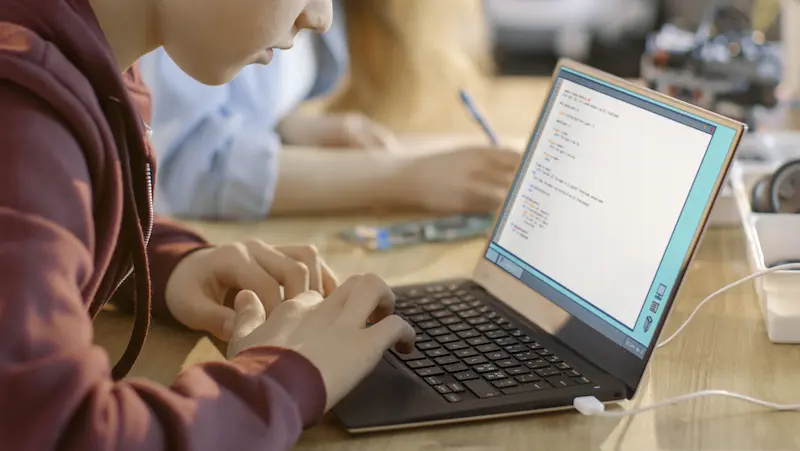Learning JavaScript at a young age not only introduces kids to the basics of programming but also lays a foundation for understanding the technology that shapes our digital lives. By exploring JavaScript, kids gain insight into the mechanisms behind the websites they use every day and the apps they enjoy on various devices.
In this article, we’ll embark on an exciting journey into the world of JavaScript tailored specifically for kids. JavaScript, often referred to as the “language of the web,” is a fantastic gateway into the realm of programming. It’s the magic wand that brings websites and games to life with interactivity and animation. With its friendly syntax and immediate visual results, JavaScript makes coding not only accessible but also incredibly fun for young minds.
Table of contents
- Understanding the Basics of Programming Languages
- Why JavaScript is the Perfect Starting Point
- Getting Started with JavaScript Syntax
- Unleashing Creativity: Kid-Centric JavaScript Projects
- JavaScript in real world applications for kids
- Benefits JavaScript for Kids
- Conclusion
- Frequently Asked Questions(FAQs)
Understanding the Basics of Programming Languages

The Importance of Teaching Kids to Code
Teaching kids to code holds immense significance in today’s rapidly evolving technological landscape. In a world where digital literacy is becoming increasingly essential, introducing children to coding early on offers a multitude of benefits.
1. Cultivating Problem-Solving Skills: Coding requires breaking down complex problems into smaller, manageable steps. Teaching kids to code nurtures their ability to approach challenges systematically, fostering critical problem-solving skills applicable beyond programming.
2. Enhancing Logical Thinking: Coding is inherently logical, demanding structured thinking and precise execution. By learning to code, kids develop logical thinking patterns that can be applied to various academic and real-life scenarios.
3. Boosting Creativity: Coding empowers kids to transform their imaginative ideas into tangible digital creations. Through coding, they learn to visualize solutions and express their creativity by designing games, websites, and interactive stories.
4. Preparing for the Future: Technology is shaping industries across the board. Familiarity with coding equips kids with a fundamental skillset that is becoming increasingly relevant across various professions, irrespective of whether they pursue careers in technology.
5. Empowering Independence: Coding teaches kids how to create and troubleshoot independently. This self-reliance boosts their confidence, as they realize their capability to tackle challenges head-on.
Why JavaScript is the Perfect Starting Point
JavaScript serves as the perfect stepping stone for kids diving into the world of coding thanks to a combination of factors that make learning both enjoyable and impactful. Its user-friendly syntax ensures that young learners can easily grasp coding concepts without being overwhelmed. What truly sets JavaScript apart is the immediate visual feedback it provides – as kids manipulate code, they witness instant changes on a webpage, making the learning process gratifying and interactive.
By learning JavaScript, kids not only build a solid foundation in coding but also hone their problem-solving skills, logical thinking, and creativity. The journey with JavaScript extends beyond coding principles; it introduces kids to the broader realm of technology, fostering a holistic understanding of how the digital landscape operates. Exploring coding for kids with JavaScript brings a world of interactive possibilities, where young learners can turn their creativity into dynamic websites and engaging games.
Getting Started with JavaScript Syntax

What is JavaScript: A Brief Overview
JavaScript is like a superpower for the web. It’s a special language that computers understand, and it’s used to make websites come alive! Imagine you’re the director of a play. JavaScript is like your script that tells the actors (which are different parts of a website) what to do. From making buttons change colors when you click them to creating pop-up messages, JavaScript is what makes the web interactive and fun.
When considering kids coding languages, JavaScript stands out as a versatile choice, allowing young learners to create interactive experiences and develop valuable programming skills.
The Basics of JavaScript Syntax:
Here are a few building blocks of JavaScript syntax that you’ll use on your coding journey:
1.Statements: These are like sentences in the coding world. Each statement is a command you give to the computer, like “Show a message” or “Move this object.”
2. Variables: Variables are like containers that hold information. They’re like labeled boxes where you can store numbers, words, or anything else you want to remember.
3. Comments: Think of comments as sticky notes for yourself and other coders. They don’t affect the code; they’re just there to explain what your code is doing.
4. Semicolons: Just like you end a sentence with a period, you end a statement in JavaScript with a semicolon. It’s like saying “I’m done talking now!”
Unleashing Creativity: Kid-Centric JavaScript Projects
Computer programming for kids with JavaScript becomes a gateway to unleashing creativity, as young minds craft their unique digital creations and interactive projects through the power of coding.
Developing a Simple Interactive Story with JavaScript
Creating an interactive story with JavaScript is like being the author of a magical adventure. With coding, kids can make characters talk, decide what happens next, and create different endings. Using variables to remember choices and conditional statements to guide the story, young storytellers can make their tales come alive. It’s a blend of creativity and coding, where imagination takes center stage, and readers become the heroes of their own digital journey.
Building a Basic JavaScript Calculator
Building a Basic JavaScript Calculator for kids is an engaging way to introduce them to coding concepts. Through interactive buttons and functions, kids can learn arithmetic operations while honing their programming skills. This project fosters logical thinking and problem-solving abilities, all while making math fun. By creating their own calculator, kids gain a sense of accomplishment and a foundation for more advanced coding projects.
JavaScript in real world applications for kids

Some of the real-world applications of JavaScript that kids can understand and relate to:
1.Website Interactivity: Explain that JavaScript is used to make websites interactive. Show them examples like buttons that change color when clicked, forms that validate input, and pop-up messages.
2. Online Games: Introduce them to simple online games like Flappy Bird or Snake, and explain that JavaScript is used to control the game logic, movements, and interactions.
3. Social Media: Discuss how JavaScript powers features on social media platforms. For instance, when they see notifications popping up or new posts loading without refreshing the page, it’s JavaScript making it happen.
4. Interactive Maps: Show them how websites like Google Maps use JavaScript to create draggable maps, place markers, and calculate directions.
5. E-commerce: Explain how JavaScript is used on e-commerce sites for things like dynamic product filters, adding items to a cart, and updating quantities in real time.
6. Weather Apps: Talk about how JavaScript can display real-time weather information, such as temperature, conditions, and forecasts, based on a user’s location.
7. Animated Websites: Show them websites with animations, such as scrolling effects, fading elements, and sliding content, which are all created using JavaScript
Checkk out coding class for kids near me.
Benefits JavaScript for Kids
Introducing JavaScript to kids offers a plethora of benefits that extend beyond mere coding knowledge:
1.Engaging Learning Experience: JavaScript provides an interactive and visually appealing way for kids to learn programming concepts. Through animations, games, and interactive web elements, they can see the immediate results of their code, making learning enjoyable and rewarding.
2. Foundation in Coding Logic: JavaScript’s syntax and concepts serve as a stepping stone to more complex programming languages. Kids can grasp foundational coding logic like variables, loops, conditions, and functions, which are applicable to various programming languages.
3. Real-World Relevance: JavaScript is used extensively in web development, making it a practical skill to possess. By learning JavaScript, kids can create dynamic and responsive web content, understanding how their code shapes the digital world around them.
4. Problem-Solving Skills: Programming encourages critical thinking and problem-solving. JavaScript projects challenge kids to break down tasks into manageable steps, fostering a systematic approach to tackling challenges.
5. Creativity and Innovation: JavaScript empowers kids to bring their creative ideas to life. Whether building games, animations, or interactive websites, they can express themselves through their coding creations.
Enroll your child in engaging programming classes for kids, where they can discover the magic of JavaScript and learn to build interactive websites and games.
Conclusion
In conclusion, delving into the world of JavaScript for kids goes far beyond teaching them a programming language it equips them with a powerful tool for creativity, problem-solving, and understanding the digital realm. Through hands-on projects, interactive games, and engaging applications, young learners not only grasp the basics of coding but also cultivate essential skills that transcend technology.
By immersing themselves in JavaScript, kids acquire a solid foundation in programming logic, setting the stage for future exploration into more advanced languages and technologies. The ability to turn imaginative ideas into tangible digital creations nurtures their innovative thinking, encouraging them to shape the virtual world according to their visions. In essence, learning JavaScript as kids is not just about coding; it’s about fostering a mindset of curiosity, adaptability, and exploration.
Exploring the insightful resources on the BrightChamps blog page has been instrumental in preparing your kids for their future growth, equipping them with valuable skills and knowledge.
Frequently Asked Questions(FAQs)
A1. Around 10-12 is a suitable age to begin teaching kids JavaScript, considering their cognitive development and basic math skills.
A2. Prior coding experience isn’t necessary; JavaScript’s visual and interactive nature makes it accessible for kids to start learning.
A3. Learning JavaScript is made fun by creating interactive games, animations, and web projects that let kids see immediate results.
A4. Online platforms like Code.org, Scratch, and Khan Academy offer kid-friendly JavaScript tutorials and projects.
A5. Yes, learning JavaScript enhances logical thinking, math skills, and digital literacy, benefiting subjects like math and science.
A6. Proficiency in JavaScript can lead to careers in web development, game design, app creation, or even technology-related fields as kids grow up.


 We are an army of educators and passionate learners from BrightChamps family, committed to providing free learning resources to kids, parents & students.
We are an army of educators and passionate learners from BrightChamps family, committed to providing free learning resources to kids, parents & students.














